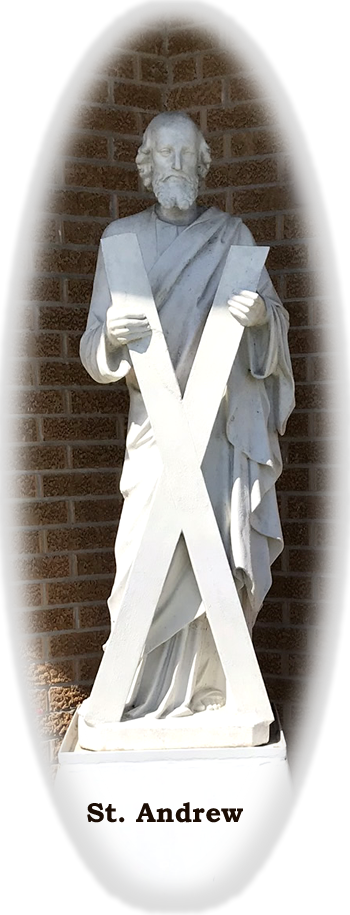OUR PATRON
 St. Andrew Parish consists of two communities, Amelia & Bayou L’Ourse with about 400 catholic families. We are located off US Hwy 90 at the corner of Julia & Francis Streets in Amelia, Louisiana.
St. Andrew Parish consists of two communities, Amelia & Bayou L’Ourse with about 400 catholic families. We are located off US Hwy 90 at the corner of Julia & Francis Streets in Amelia, Louisiana.
St. Andrew Parish has been named after St. Andrew the Apostle. He was the brother of St. Peter, and knows as the Patron of Fishermen.St. Andrew was called by Jesus to leave his nets and to become a fisher of men. He and the other apostles accomplished this by preaching the Gospel, the Good News, to others. St. Andrew’s mission has also become our mission too. It is to evangelize, to reach-out to others.
But how can they call to him for help if they have not believed? And how can they believe in him if they have not heard the message? And how can they hear if the message is not proclaimed? And how can the message be proclaimed if the messengers are not sent out?
As the scriptures say, ‘How wonderful is the coming of messengers who bring the good news!’ Romans 10:14-15 Pope Paul VI said, “The Church exists to evangelize.” In Go and Make Disciples: A National Plan and Strategy for Catholic Evangelization in the United States, the U.S. Bishops summarized the essential purpose of evangelization as “bringing the Good News of Jesus Christ into every human situation and seeking to connect individuals and society by the divine power of the Gospel itself.” (GMD, 2)
The church can accomplish this task through the life and witness of its members. We are the disciples who need to be enthusiastic, reaching out to others by the way we profess and witness to our faith. One cannot give what one does not possess. Ultimately, to evangelize effectively, we must become an evangelizing community.
St. Andrew Parish is trying to continue the missions of evangelization in reaching out to: YOUTH through Religious Education; and Youth Ministry; to YOUNG ADULTS through Young Adult Ministry; and to the COMMUNITY AT LARGE especially through Renew 2000 and Parish Rally 2000 including a special focus on Young Adults.
It is our hope that as we here at St. Andrew’s strive to connect more and more with our community, the process of evangelization will continue to the next generation. As we learn more about our faith may we also come to the realization that we are called to live and witness that faith, to share our stories,and to gather together in worship as we continue to reach out to the whole human family.
Feast Day: November 30 Patron of Fisherman St. Andrew, whose feast day is November 30th, is the patron saint for fishermen. Andrew, like his brother, Simon Peter, was a fisherman. He became a disciple of the great St. John the Baptist, but when John pointed to Jesus and said, “Behold the Lamb of God!” Andrew understood that Jesus was greater. At once he left John to follow the Divine Master. Jesus knew that Andrew was walking behind him, and turning back, he asked, “what do you seek?”
When Andrew answered that he would like to know where Jesus lived, Our Lord replied, “Come and see.” Andrew had been only a little time with Jesus when he realized that this was truly the Messiah.From then on, he decided to follow Jesus. Andrew was thus the first disciple of Christ. Next, Andrew brought his brother Simon (St. Peter) to Jesus and Jesus received him, too, as His disciple.At first the two brothers continued to carry on their fishing trade and family affairs, but later, the Lord called them to stay with Him all the time. He promised to make them fishers of men, and this time,they left their nets for good.
It is believed that after Our Lord ascended into Heaven, St. Andrew went to Greece and Asia Minor to preach the gospel. He is said to have been put to death in Patras in Southern Greece on a diagonal cross, to which he was tied, not nailed. He lived two days in that state of suffering, still preaching to the people who gathered around their beloved Apostle.Some 300 years after his death, the Emperor Constantine was going to move the saints bones, and legend has it that a monk was warned of this in a dream by an angel, who told him to remove the saints bones to the “ends of the Earth” to keep them safe.Scotland was as near to the ends of the ancient Greek world as you could get, and that is how his remains came to be taken to Scotland.
The monk brought the holy relics ashore at what is now St Andrews.A chapel was built to house them, and by 1160 a cathedral. St Andrews was the religious capital of Scotland, and the goal of many pilgrims.The saints remains have now disappeared, probably destroyed during the Scottish Reformation, when the strictures of Calvinism tended to wish to remove traces of Catholic “idolatry”.
The site of the relics is now marked by a plaque in the ruins of the Cathedral in St Andrews.Interestingly, some of Saint Andrew’s bones were taken to Amalfi in Italy. From there the church sent some fragments in 1879 to Scotland. And in 1969, Pope Paul VI gave some further relics to to the Catholic church in Scotland during a visit to Scotland.
Two countries have chosen St. Andrew as their patron – Russia and Scotland.